Smoke, Mirrors, and Murder and Other True Cases Read online
Praise for “America’s Best
True-Crime Writer” (Kirkus Reviews) and
her #1 New York Times Bestselling Series
ANN RULE’S CRIME FILES
Twelve riveting volumes of true-crime stories
drawn from her personal collection
“Chilling cases…. A frightening, fascinating rogue’s gallery of mercenary murderers.”
—Mystery Guild
“Prolific and talented Rule proves her warranted reputation as one of true crime’s leading lights…. With a novelist’s skill, Rule brings to life a rich case.”
—Publishers Weekly (starred review)
“Spine-tingling…could win a place in any insomniac’s heart.”
—Barnesandnoble.com
“Fascinating, unsettling tales…. Among the very small group of top-notch true-crime writers, Rule just may be the best of the bunch.”
—Booklist
“Rule’s ability to depict both criminals and victims as believable human beings is perfectly embodied in this sad, fascinating account.”
—Library Journal
“Gripping tales…. Fans of true crime know they can rely on Ann Rule to deliver the dead-level best.”
—The Hartford Courant (CT)
MORE MUST-READ TRUE CRIME FROM ANN RULE—DON’T MISS THESE CELEBRATED BESTSELLERS
GREEN RIVER, RUNNING RED
“[Rule] conveys the emotional truth of the Green River case.”
—Los Angeles Times
“Riveting…. Rule infuses her case study with a personally felt sense of urgency.”
—People
“Perhaps Rule’s finest work…holds the reader in a firm grip.”
—Statesman Journal (Salem, OR)
“Rule gives full, heartbreaking emotional weight to what America’s most notorious serial killer truly wrought. A must for the author’s legions of fans.”
—Booklist
HEART FULL OF LIES
“A convincing portrait of a meticulous criminal mind.”
—The Washington Post
“Rule knows a good drama when she finds one…. A real-life soap opera.”
—Publishers Weekly
“Fascinating and strange…. The sheer weight of [Ann Rule’s] investigative technique places her at the forefront of true-crime writers.”
—Booklist
EVERY BREATH YOU TAKE
“Affecting, tense, and smart true crime…. A case study of the classic American con man crossed with the more exotic strains of the sociopath.”
—Washington Post Book World
“Ann Rule has outdone herself.”
—The Orlando Sentinel (FL)
“Absolutely riveting…psychologically perceptive.”
—Booklist
…AND NEVER LET HER GO
“Truly creepy…. This portrait of an evil prince needs no embellishment.”
—People
“[Rule] might have created her masterpiece.”
—The Plain Dealer (Cleveland)
“Even crime buffs who followed the case closely [will] gain new insights.”
—The Orlando Sentinel (FL)
“[Rule] tell[s] the sad story with authority, flair, and pace.”
—The Washington Post
BITTER HARVEST
“A must-read story of the ’90s American dream turned, tragically, to self-absorbed ashes.”
—People
“Impossible to put down…. A tour de force.”
—Kirkus Reviews
Books by Ann Rule
Too Late to Say Goodbye
Green River, Running Red
Heart Full of Lies
Every Breath You Take
…And Never Let Her Go
Bitter Harvest
Dead by Sunset
Everything She Ever Wanted
If You Really Loved Me
The Stranger Beside Me
Possession
Small Sacrifices
Ann Rule’s Crime Files
Vol. 12: Smoke, Mirrors, and Murder and Other True Cases
Vol. 11: No Regrets and Other True Cases
Vol. 10: Worth More Dead and Other True Cases
Vol. 9: Kiss Me, Kill Me and Other True Cases
Vol. 8: Last Dance, Last Chance and Other True Cases
Vol. 7: Empty Promises and Other True Cases
Vol. 6: A Rage to Kill and Other True Cases
Vol. 5: The End of the Dream and Other True Cases
Vol. 4: In the Name of Love and Other True Cases
Vol. 3: A Fever in the Heart and Other True Cases
Vol. 2: You Belong to Me and Other True Cases
Vol. 1: A Rose for Her Grave and Other True Cases
Without Pity: Ann Rule’s Most Dangerous Killers
The I-5 Killer
The Want-Ad Killer
Lust Killer
Copyright © 2008 by Ann Rule
All rights reserved, including the right to reproduce this book or portions thereof in any form whatsoever.
For information address Pocket Books Subsidiary Rights Department, 1230 Avenue of the Americas, New York, NY 10020
POCKET and colophon are registered trademarks of Simon & Schuster, Inc.
ISBN-10: 1-4165-7741-6
ISBN-13: 978-1-4165-7741-6
Visit us on the World Wide Web:
http://www.SimonandSchuster.com
I am dedicating this book to two people who took a chance on me—a virtually unknown writer—many years ago: Joan and Joe Foley of the Foley Agency, New York City. Some authors change literary agents as often as they buy new cars, but I am sticking with the Foleys! They have long since become friends who are as close to me as family. I appreciate their pep talks, support, constructive criticism, experience, knowledge, and the fact that they always have my back. We have shared both ebullient good times and tragedies over the years, as all good friends do.
Thanks, Foleys!
Acknowledgments
There are many cases in this book, all of them carefully investigated and researched, and all but two successfully prosecuted. I count on the survivors, witnesses, patrolmen, detectives, medical examiners, prosecutors, and judges as my resources as I seek the truth about what really happened. And I was, indeed, lucky to have found such cooperation from those who brought truth and justice out of mystery and tragedy in the cases featured in Smoke, Mirrors, and Murder.
I wish to thank Sue Jensen, Jenny Jensen, and Scott Jensen; Detectives Cloyd Steiger and Sharon Stevens, Seattle Police Department; Cheryl Snow and Marilyn Brenneman, Senior Deputy King County Prosecuting Attorneys; Val Epperson and Superior Court Judge Richard Jones.
To Captain Herb Swindler and Assistant Chief Noreen Skagen, Seattle Police Department, and Ila Birkland, the most efficient secretary the Homicide Unit, Seattle Police Department, ever had.
To Inspectors Bill Hoppe, Jim Reed, and Jack Hickam of the Seattle Fire Department.
To Detectives Jim Byrnes and Jan Cummings, Marion County, Oregon, Sheriff’s Department; and Robert Hamilton, Oregon State Attorney General’s Office.
To Detectives Sgt. Ivan Beeson and Sgt. Don Cameron, and Detectives Dick Reed, Dick Sanford, Billy Baughman, George Marberg, Joyce Johnson, and Al Gerdes, Seattle Police Department.
To my first—and only—research assistant, Tennessee Division: Beverly Morrison, in Henderson. And to McNairy County, Tennessee, Circuit Court Clerk Ronnie Brooks and Clerk Jackie Cox, Russell Ingle of the Independent-Appeal, Selmer, Tennessee; Tonya Smith-King of the Jackson Sun, Jackson, Tennessee, and Malley J. Byrd, Memphis, Tennessee.
As always, many, many th
anks to my editorial team at Pocket Books: to my publisher, Louise Burke, whose enthusiasm is contagious; to my editor, Mitchell Ivers, whose voice on the phone or name on my e-mail is almost always cause for a smile. He still gives me more compliments and back pats than complaints; to his editorial assistant, Erika Burns, who put this book together—photo section and all—in perfect order on a tight deadline. And to the rest of the team, who worked efficiently and promptly, using more effort than readers—and sometimes authors—ever realize. I do appreciate you. Thanks also to Carly Sommerstein, Sally Franklin, and Lisa Litwack. And a special thank-you to Chuck Antony, the copy editor who sent back such a sweet-smelling manuscript. Thank you all!
Contents
Foreword
The Deputy’s Wife
One: Happy Ever After?
Two: Secrets and Lies
Three: A Deadly Conspiracy
Four: Closing In
Five: Trial
The Antiques Dealer’s Wife
The Truck Driver’s Wife
The Convict’s Wife
The Chemist’s Wife
The Painter’s Wife
The Minister’s Wife
Selmer, Tennessee
Mary and Matthew
Afterword
Photographic Insert
Foreword
Murder is a crime shot through with deception, subterfuge, wicked preparation, and cruel intent. By its very definition it involves trickery and lies; killers almost always seek to hide behind real or imaginary smoke screens, attempting to convince others of their innocence. They are, in a sense, “magicians of malice,” intent on covering up the truth. Some are far more clever than others and their intricate plots often come frighteningly close to allowing them to walk away with few or no consequences. And there are always some who do escape punishment. Unfortunately, there is such a thing as the perfect murder.
The cases that follow cover the gamut of every genus of murderer; some were brilliant, while others were cloddish. One case may not have been a homicide but only a tragic circumstance that was virtually unexplainable. No one knows for sure. There is even a homicide case that may have had as its “watershed point” an Internet con game.
Each case is especially memorable to me, whether it happened as recently as 2007 or took me back to the seventies and eighties, when I first began writing for the fact-detective magazines. In those days, I was known as Foreword “Andy Stack”—because the editors of True Detective said their readers would not believe a woman knew anything about police investigations. It took me years, but I proved them wrong.
In this, my twelfth book in the Crime Files series, I include seven engrossing cases, winnowed out from the hundreds I have researched over the years: “The Deputy’s Wife” (the book-length feature), “The Antiques Dealer’s Wife,” “The Truck Driver’s Wife,” “The Convict’s Wife,” “The Chemist’s Wife,” “The Painter’s Wife,” and, finally, “The Minister’s Wife.” Murder interrupted all their marriages.
Each of these bizarre stories had hidden aspects that surprised me when I first encountered them, even though I sometimes think that nothing can catch me unaware after so many years of writing true-crime cases.
But something always does. These cases did, and I hope they will keep you in suspense too. Whether in fiction or in real life, mystery intrigues us all. Every story I include in this collection explores the relationship between men and women, which in these cases proved to be an incendiary mix. In some, the male is the dangerous persona, in some the female—and there are a few in which you, the reader, will have to decide which one was the guilty party. The cases all involved deception, large and small lies that led inevitably to disaster.
Ann Rule
The
Deputy’s Wife
When I type the last page of a book, I am always struck by the same thought: how terribly stupid the convicted felon was! This killer had so much to be thankful for, and yet this macabre murder plot is so full of evil that it makes me shiver. The gleeful killer-to-be was “tickled pink” at a scenario designed to make multiple homicides look like an accident. The greedy plotter threw a good life away to end up with nothing—less than nothing.
This case is about a tragedy on its way to happening, and the cast of characters is as diverse and extraordinary as any I have come across. It is a recent case, its strange events playing out in the last few years.
Tragically, this case is reminiscent of the hundreds of e-mails and letters I receive from desperate husbands and wives—mostly wives. I always wish I could do more to help, but perhaps shedding light on one family’s disintegration may encourage readers to face their own domestic problems and deal with them before it is too late.
I don’t think anyone who looks at life through barred windows ever really expected to be behind them. And yet a prisoner’s world becomes, for a time—or for life—one of spartan cells, walls with billows of razor wire atop them, bland food heavy on carbohydrates, and the same daily routine with orders issued by corrections officers. Worst of all, prisoners lose their freedom to come and go as they please. Even though I have been only a visitor in jails and prisons, I dread the sound of a steel door clanging shut behind me—along with the smell of Pine-Sol, cigarettes (although they are now forbidden in most prisons), urine, sweat—and the contagious sense of hopelessness.
A most unlikely prisoner is the antihero in this story, and I have no doubt at all that this individual’s ending up in that role was shocking to everyone involved. This person started life with numerous disadvantages, but eventually found love, family, children, respect, and what seemed to be the good life.
And then this murderous plotter threw it all away.
More than ever before, tabloids and the Internet are rife with divorce and custodial battles as America moves into the twenty-first century. Celebrities like Britney Spears and Kevin Federline, Kim Basinger and Alec Baldwin, and a dozen other famous couples seem more intent on winning than concerned about their children’s security, thus mirroring the divorce wars of everyday people. Once marital vows shatter, couples on every level of society begin to struggle over who will get the children, who will get the money, the house, the vehicles.
Perhaps the events in this case would have happened even without divorce and property division struggles, but with the enmity that surfaced in what was anything but a simple divorce, an icy hatred began to grow, making the end of a marriage a horror story.
Could one half of a once-loving partnership be insatiable enough when it came to wealth that the lives of those who got in the way meant less than zero?
I think so.
Looking back with the clarity of hindsight, it is easy to spot signs of danger. They were as brief as a jagged sword of lightning stabbing down to a dark beach or a flicker of fire before a woods is engulfed in flames. But the signs were there, just as they are for many trusting partners. A flash of insight, buried quickly in denial.
We think we know someone as well as we know ourselves.
But we don’t.
One
Happy Ever After?
Sue Harris and her sister, Carol,* who was seven years older, grew up in an upper-middle-class home in Lake Hills, the most popular subdivision in Bellevue, an eastern suburb of Seattle, in the 1950s. Bellevue was like Levittown or a thousand other towns that sprang up after World War II, fulfilling the demand for new homes for young families. Initially it seemed a long way from Seattle, but it really wasn’t, and when the first floating bridge across Lake Washington was built, Bellevue seemed only a hop, skip, and a jump away for the dads who continued to work every day. The moms mostly stayed home, waxed their floors once a week, and cooked meals from scratch, and if they had a career, it was probably selling Avon or Mary Kay products part-time.
In many ways the 1950s were an easier time, or maybe it just seemed that way. Couples got married intending to stay together, and the divorce epidemic that lay ahead was only a distant threat.
Alo
ng with most of the other fathers in the neighborhood, Sue and Carol’s father, Hermann, was an engineer for the Boeing Airplane Company. Sue was born in December 1955, and despite the difference in their ages, she and her sister were uncommonly close as children, and that would continue as they grew to adulthood. If they expected life to be happy ever after, so did other little girls in Bellevue. It was the era of Barbie and Ken and playing dolls while mothers lingered over coffee in somebody’s kitchen.
In Lake Hills, the fifties were a halcyon time. In the early sixties, though, couples with young children came close to panic when the Cuban missile crisis loomed. World War II had been fought far away, across oceans, but the Cuban crisis threatened to bring war to America itself. With that menace and the simultaneous anxiety it provoked, a small army of salesmen swarmed over Bellevue offering bomb shelters on the installment plan.
A model home in Lake Hills offered the latest upgrade in housing: a bomb shelter in the basement. And Rod Serling’s Twilight Zone featured a memorable episode about neighbors fighting one another to crowd into such a shelter. It was the end of a time when everyone felt safe. Most home owners opted to move forward without shelters, realizing that their consciences wouldn’t allow them to survive happily when most of their neighbors had perished.
And then John F. Kennedy was assassinated on November 22, 1963, and America changed forever.
Hermann Harris had clipped articles on bomb shelters, but his daughters weren’t aware of that until after he died—much too young, at fifty-two—of a sudden heart attack. Their mother, Lorraine, was only forty-two when she was left to raise her two daughters: Sue was ten and Carol was eighteen. Fortunately, Hermann Harris had been wise in his investments and he left his family well provided for, and there were veteran’s benefits from his service in World War II that would pay for his two girls to go to college.

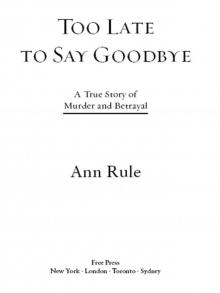 Too Late to Say Goodbye: A True Story of Murder and Betrayal
Too Late to Say Goodbye: A True Story of Murder and Betrayal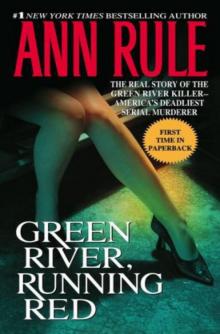 Green River, Running Red
Green River, Running Red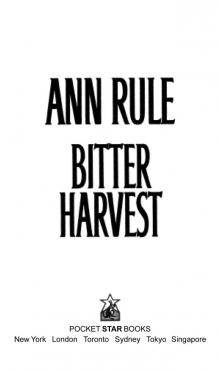 Bitter Harvest
Bitter Harvest Dead by Sunset: Perfect Husband, Perfect Killer?
Dead by Sunset: Perfect Husband, Perfect Killer?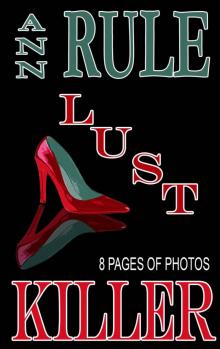 Lust Killer
Lust Killer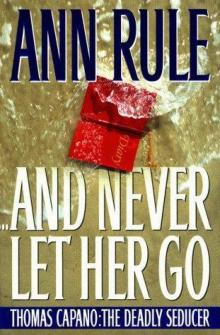 And Never Let Her Go: Thomas Capano: The Deadly Seducer
And Never Let Her Go: Thomas Capano: The Deadly Seducer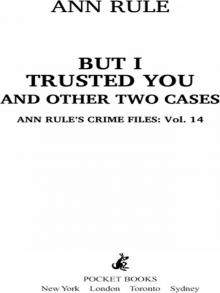 But I Trusted You and Other True Cases
But I Trusted You and Other True Cases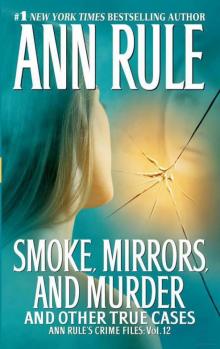 Smoke, Mirrors, and Murder and Other True Cases
Smoke, Mirrors, and Murder and Other True Cases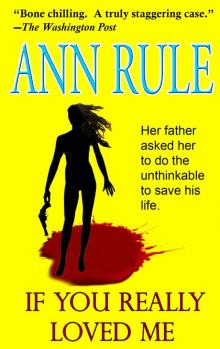 If You Really Loved Me
If You Really Loved Me Kiss Me, Kill Me and Other True Cases
Kiss Me, Kill Me and Other True Cases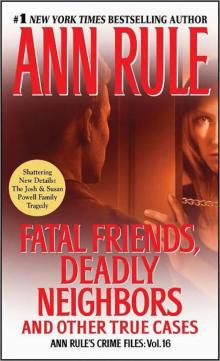 Fatal Friends, Deadly Neighbors and Other True Cases
Fatal Friends, Deadly Neighbors and Other True Cases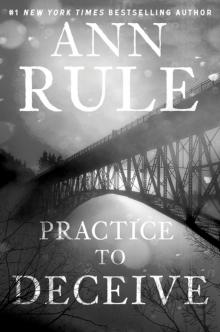 Practice to Deceive
Practice to Deceive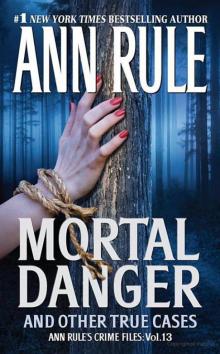 Mortal Danger and Other True Cases
Mortal Danger and Other True Cases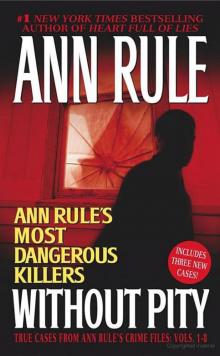 Without Pity: Ann Rule's Most Dangerous Killers
Without Pity: Ann Rule's Most Dangerous Killers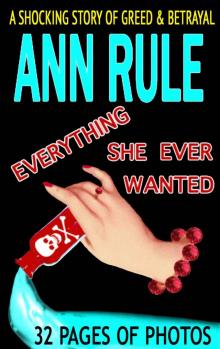 Everything She Ever Wanted
Everything She Ever Wanted A Fever in the Heart and Other True Cases
A Fever in the Heart and Other True Cases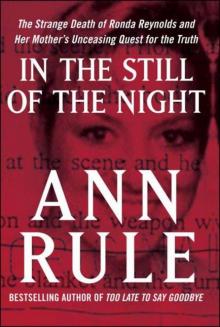 In the Still of the Night
In the Still of the Night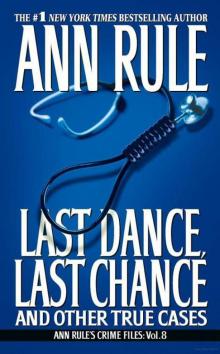 LAST DANCE, LAST CHANCE - and Other True Cases
LAST DANCE, LAST CHANCE - and Other True Cases A Rage to Kill
A Rage to Kill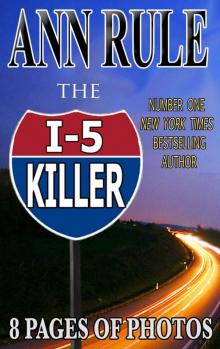 The I-5 Killer
The I-5 Killer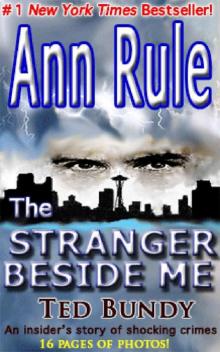 The Stranger Beside Me
The Stranger Beside Me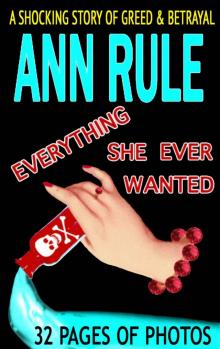 Everything She Ever Wanted: A True Story of Obsessive Love, Murder, and Betrayal
Everything She Ever Wanted: A True Story of Obsessive Love, Murder, and Betrayal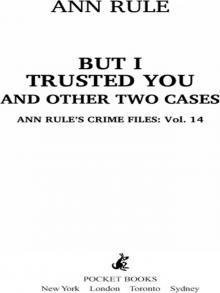 But I Trusted You
But I Trusted You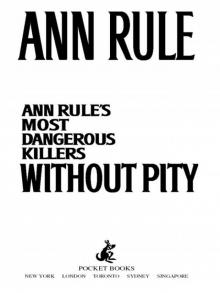 Without Pity
Without Pity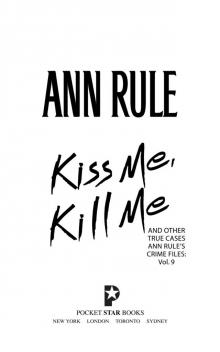 Kiss Me, Kill Me
Kiss Me, Kill Me Too Late to Say Goodbye
Too Late to Say Goodbye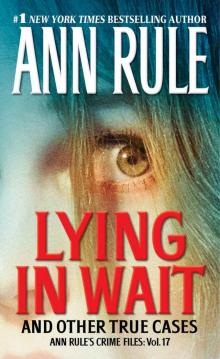 Lying in Wait
Lying in Wait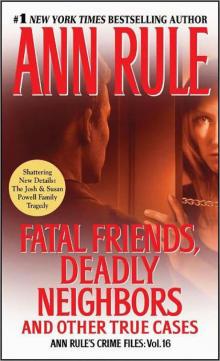 Fatal Friends, Deadly Neighbors
Fatal Friends, Deadly Neighbors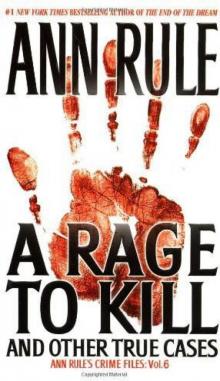 A Rage to Kill: And Other True Cases
A Rage to Kill: And Other True Cases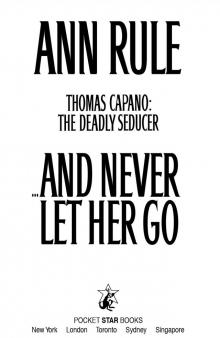 And Never Let Her Go
And Never Let Her Go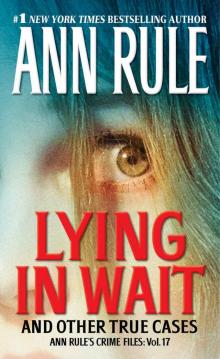 Lying in Wait Ann Rule's Crime Files Vol.17
Lying in Wait Ann Rule's Crime Files Vol.17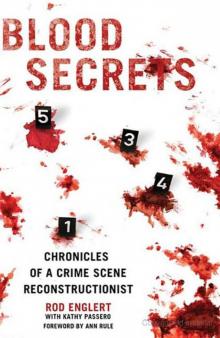 Blood Secrets: Chronicles of a Crime Scene Reconstructionist
Blood Secrets: Chronicles of a Crime Scene Reconstructionist No Regrets
No Regrets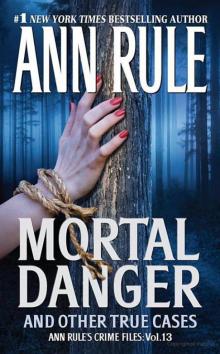 Mortal Danger
Mortal Danger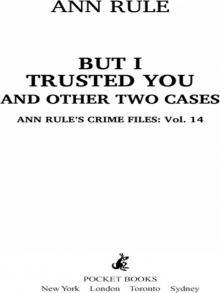 But I Trusted You: Ann Rule's Crime Files #14
But I Trusted You: Ann Rule's Crime Files #14 Empty Promises
Empty Promises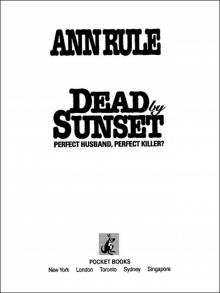 Dead by Sunset
Dead by Sunset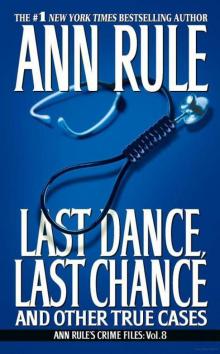 Last Dance, Last Chance
Last Dance, Last Chance Don't Look Behind You
Don't Look Behind You